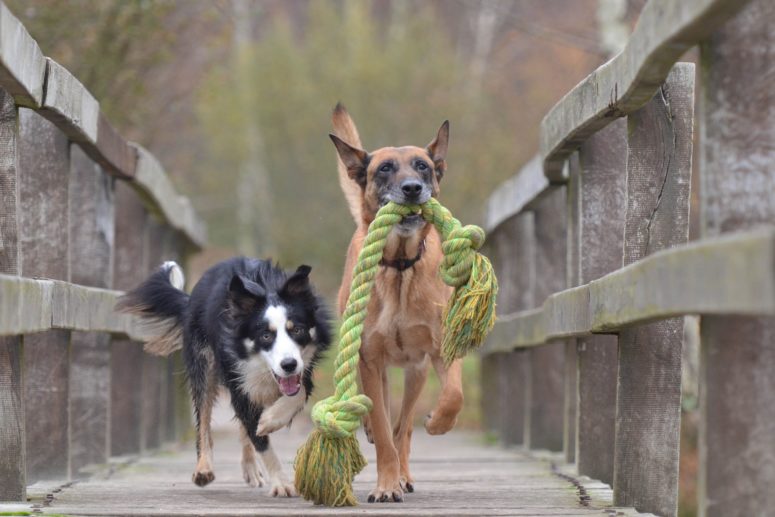
A CCL injury is no fun for your dog. Think of it like an ACL injury in humans – painful and limiting, but a typically positive outlook for healing and getting back to regular activity. There are varying treatments your veterinarian may prescribe for an injured CCL, and by following through with the advised care, your pet will be active again in no time.
In the past we’ve covered what can increase your pet’s risk for CCL (Cranial Cruciate Ligament) tears or ruptures, which can occur chronically (slowly over time) or as a result of an isolated incident. As a brief recap, here are the top risk factors:
- Knee deformities that put more stress on the CCL
- Obesity (increases stress on all support structures)
- Age. Animals over age 5 often have decreased strength and increased stiffness of CCL.
- Past injury of the opposite CC
- Immune diseases
- Breed (according to statistics ). Breeds more prone to CCL injury include Mastiffs, Akitas, St. Bernards, Rottweilers, and Labs.
If your dog is – or potentially will be – diagnosed with a CCL injury, you may be curious about the various treatments vets consider before making a recommendation. With all treatments, the goal is to relieve pain, restore, or at least improve, mobility, and slow the onset of degenerative diseases. Below is an in-depth look at a few of the corrective routes. You can also check out our services page for an overview of our surgical procedures for CCL injuries.
Note: If you suspect your dog is injured, please see a veterinary professional for accurate diagnosis and the most effective treatment plan.
Nonsurgical
While minor tears in the CCL often become full ruptures (it’s hard to keep dogs from aggravating activities!), taking early action can help. Conservative treatment options, if fully adhered to, can be effective for healing or at least controlling the injury. This is especially true for small dogs.
Conservative treatment includes rest, rehab, pain medication, and weight maintenance. If you need ideas for keeping your dog at rest for an extended period of time, see our post on keeping your dog inactive after surgery (it applies to caring for any type of injury).
Surgical
For advanced cases, larger dogs, or athletic/performance dogs, conservative treatment alone probably won’t cut it. In most cases of CCL injuries, these measures are prescribed along with surgery; unfortunately, ligament tears are likely to progress and leaving them untreated often results in injury to the opposite leg. Further, surgery is the only correction for a fully ruptured CCL.
TPLO (tibial plateau leveling osteotomy), while an invasive procedure, is considered the gold-standard correction for a torn CCL in dogs.
The procedure involves adjusting the proximal tibia to eliminate the need of the CCL for stabilizing the knee joint. During surgery, a TPLO-specific saw is used to make a very precise cut through the tibial plateau, altering its slope. It is then rotated slightly. This stops the femur from sliding down the tibial plateau when the knee is bearing weight. Once the correction/rotation is made, a specialized plate and set of screws is used to secure the bone.
TPLO surgery has a faster recovery time than other procedures, and is the preferred route for avoiding long-term pain medications and enabling very active dogs to resume normal exercise.
Our recovery regimen for a TPLO: It’s crucial for the patient to undergo 8-12 weeks of very strict exercise restriction. During the recovery phase, the body will repair the external incision and the osteotomy (cut through the tibia). Rechecks occur around 2 weeks and 8 weeks post-op. The 2 week recheck is to ensure the incision is fully healed and that the patient is progressing appropriately. X-rays will be taken at the 8 week recheck to determine if the surgical site has healed. Once fully healed, the plate and screws will no longer be necessary, but will remain in place unless they cause issues.
Lateral Suture Correction is the preferred surgical solution for small dogs (30 pounds or less) and may also be appropriate for sedentary dogs.
The goal of the procedure is to stabilize the dog’s knee by using monofilament (a single stand of fiber very similar to fishing line) on the outside of the knee joint. The suture is looped through the front part of the tibia, then looped around the fabellar bone. It’s designed to mimic the original ligament and prevent abnormal joint movement. Over time scar tissue will form around the area, providing more permanent stabilization.
As with any surgical procedure, a Lateral Suture correction requires strict rest post-op. However, full recovery and efficacy requires a longer period of limited activity than with other approaches. Physical therapy may be prescribed as well. The Lateral Suture stabilization allows most dogs to return to normal activity levels.
In cases of injury, your vet will help determine the best treatment options for your pet. Still, it doesn’t hurt to educate yourself on what the various treatments entail and why an expert may recommend one over another.
Because we understand the stress and high cost of surgical referrals, we strive to be an accommodating and attentive (and mobile!) alternative. We’ll work with you to determine the best approach and care plan. There’s no “one size fits all” solution for a torn CCL, but the goal is always the same: getting your pet back to it’s healthy, happy, and active life!
